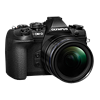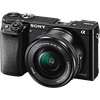Main
Model
Price
Advantages
launch
Announced
Body type
Camera subcategory
Sensor
Effective pixels
Max resolution
Sensor size
Sensor type
Processor
Image ratio w:h
Sensor photo detectors
Other resolutions
Image
ISO
Boosted ISO (minimum)
White balance presets
Custom white balance
Image stabilization
Image stabilization notes
Uncompressed format
JPEG quality levels
Photography features
Minimum shutter speed
Maximum shutter speed
Maximum shutter speed (electronic)
Aperture priority
Shutter priority
Manual exposure mode
Subject / scene modes
Built-in flash
Flash range
External flash
Flash modes
Continuous drive
Self-timer
Metering modes
Exposure compensation
AE Bracketing
WB Bracketing
Screen / viewfinder
Articulated LCD
Screen size
Screen dots
Touch screen
Screen type
Live view
Viewfinder type
Viewfinder coverage
Viewfinder magnification
Viewfinder resolution
Videography features
File Format
Microphone
Speaker
Resolutions
Optics & Focus
Autofocus
Number of focus points
Lens mount
Focal length multiplier
Digital zoom
Manual focus
Physical
Weight (inc. batteries)
Dimensions
Environmentally sealed
Battery
Battery details
Battery Life (CIPA)
Storage
Storage types
Connectivity
USB
HDMI
Microphone port
Headphone port
Wireless
Remote control
Wireless notes
Other features
Orientation sensor
Timelapse recording
GPS
Samples
Videos
Summary
The Alpha a6000 highest resolution of 6000 x 4000 pixels (24 megapixels) is better in comparison with the OM-D E-M1 Mark II highest resolution of 5184 x 3888 pixels (20 megapixels). The Alpha a6000 has larger sensor than the OM-D E-M1 Mark II: APS-C (23.5 x 15.6 mm) versus Four Thirds (17.4 x 13 mm). It is the most significant difference between these cameras because big sensor allows you to make photos of the more professional quality. The Alpha a6000 has a wider ISO range of 100-25600 than 200-25600 ISO range of the OM-D E-M1 Mark II. This ISO numbers allow you to make better photos in more difficult conditions. The Alpha a6000 provides more presets of white balance - 10. This specification gives you more control over colour. The Alpha a6000 provides more number of focus points than the OM-D E-M1 Mark II: 179 vs 121. More focus points means less risk of losing focus lock during tracking a moving object.
The OM-D E-M1 Mark II is equipped with articulated display which will allow you to make great selfies. The OM-D E-M1 Mark II display is better as it has more number of screen dots 1,037,000 in compare to 921,600 dots of the Alpha a6000 screen. The higher dot count display is better for reviewing images on your camera. The OM-D E-M1 Mark II has a touch screen.
The Alpha a6000 has built-in flash. The OM-D E-M1 Mark II is environmentally sealed i.e. the camera will be safe even uncovered if you are out shooting in the rain and snow. The Sony Alpha a6000 weighs 344g which is 230g less in comparison with the weight of the OM-D E-M1 Mark II.
The Sony Alpha a6000 has 11 advantages and the OM-D E-M1 Mark II only 9 so the Alpha a6000 will become the best buy. Get the list of the best offers on Amazon.


